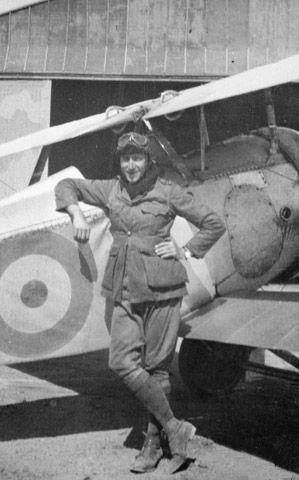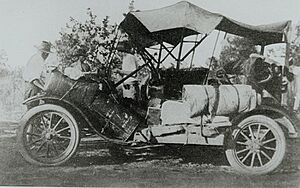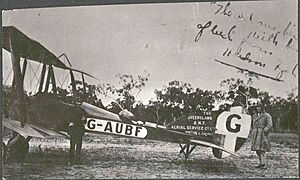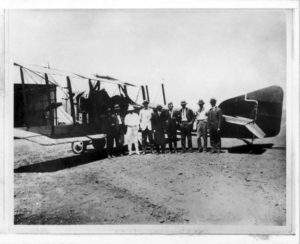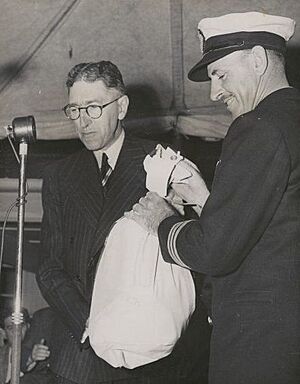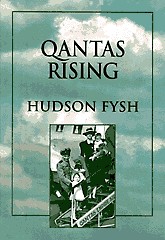Hudson Fysh facts for kids
Quick facts for kids
Hudson Fysh
|
|
|---|---|
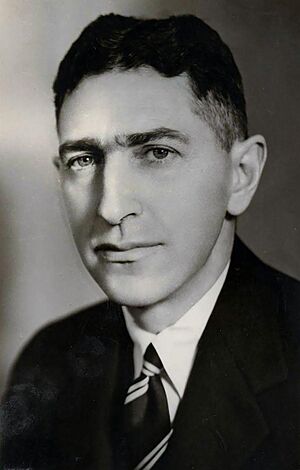
A portrait of Wilmot Hudson Fysh ca. 1935
|
|
| Born | 7 January 1895 |
| Died | 6 April 1974 (aged 79) |
| Known for | Co-founding Qantas |
| Spouse(s) | Elizabeth Elinor Dove |
| Relatives | Henry Reed Sir Philip Fysh |
| Awards | Knight Commander of the Order of the British Empire Distinguished Flying Cross |
| Aviation career | |
| Full name | Sir Wilmot Hudson Fysh |
| Famous flights | First revenue flight in Australia |
| Flight license | February 1919 Heliopolis, Egypt |
| Air force | Australian Flying Corps Royal Air Force |
| Battles | World War I World War II |
| Rank | Squadron Leader |
Sir Wilmot Hudson Fysh (born January 7, 1895 – died April 6, 1974) was an important Australian pilot and businessman. He is best known as one of the people who started the Australian airline company Qantas. Hudson Fysh was born in Launceston, Tasmania.
During World War I, Fysh served as a soldier in the Australian Light Horse Brigade. He later became an observer and gunner in the AFC, flying with Paul McGinness. For his brave actions in the air, he received the Distinguished Flying Cross after the war.
In 1920, Fysh, along with Paul McGinness and Sir Fergus McMaster, founded Qantas. Even when the government later took ownership of Qantas, Fysh remained in charge as managing director and chairman. He was also involved in international aviation groups and helped start the Australian National Travel Association. Fysh was also known for writing books about the history of aviation, especially about Qantas. He passed away in Paddington at the age of 79.
Contents
Early Life and Family
Wilmot Hudson Fysh was born in Launceston, Tasmania, Australia, on January 7, 1895. His father, Frederick Wilmot Fysh, was a merchant. His mother, Mary, was the daughter of a well-known landowner, Henry Reed. Hudson was the oldest of five children. He was also the great-nephew of Sir Philip Fysh, who was a politician.
Hudson's childhood was a bit tough because his parents' marriage had problems, and his father's business failed. He went to Launceston and Geelong schools. After school, he worked as a jackaroo, which is like a trainee on a sheep or cattle farm. He also learned to classify wool.
As a teenager, he was a cadet in the army. When World War I started in 1914, he joined the Light Horse. Later in life, after Qantas was founded, Fysh studied economics to improve his business skills. In 1971, the University of Tasmania gave him an honorary degree in engineering.
People described Fysh as a smart businessman who was very determined. He was also known for being strict. However, he was also described as "shy" and "quiet." He once said he felt "painfully shy" as a child and that these feelings never really left him.
On December 5, 1923, Fysh married Elizabeth Eleanor Dove. They had a son, John, and a daughter, Wendy. Their children were born in Longreach, Queensland. Fysh often said his family was his strong support system against the pressures of his work.
World War I Experiences

On August 25, 1914, Hudson Fysh joined the 3rd Regiment of the 1st Australian Light Horse Brigade. This happened after the start of World War I. He began as a private soldier. On October 20, 1914, he sailed from Hobart to Egypt.
After training in Egypt, Fysh arrived at Gallipoli in May 1915. This was just two weeks after the first Australian and New Zealand soldiers (Anzacs) had landed there. He served for seven months and was evacuated in December 1915. He later described living "like rats in their holes" at Gallipoli.
Fysh then served in Palestine and Sinai. He fought in the Palestine Campaign with the Light Horse Regiment. In January 1917, he was promoted to lieutenant. He fought under Lieutenant Ross Smith, who later became a famous pilot.
In July 1917, Fysh asked to join the Royal Flying Corps. After several months of training, he became an observer and gunner in October 1917. He flew with the No. 1 Squadron of the Australian Flying Corps. He was the gunner for Major Sydney W. Addison and later for Lieutenant Paul McGinness.
Fysh flew in a Bristol Fighter against German and Turkish planes. He was very skilled and shot down five enemy aircraft. For his bravery, he was recommended for the Distinguished Flying Cross on January 8, 1919. This award recognized his courage in air combat and for attacking targets on the ground.
His award citation mentioned his actions on August 31, 1918. On that day, he helped destroy two enemy planes. It also noted his skill and bravery on other occasions, where he destroyed enemy aircraft or forced them to land.
Building Qantas: A Pioneer's Journey
Surveying for the Great Air Race
On February 28, 1919, Hudson Fysh earned his flying license in Heliopolis, Egypt. He became a scout pilot. In March 1919, the Australian Prime Minister announced a "Great Air Race." The goal was to be the first to fly from Great Britain to Australia. The prize was £A10,000.
Fysh decided to join the race with Paul McGinness as his co-pilot. They planned to get funding from Sir Samuel McCaughey. However, McCaughey died, and his family refused to provide the money. So, their race plans were cancelled.
Instead, Fysh and McGinness were asked to survey Northern Australia. They needed to find good routes for planes for the Air Race. Their job was to map a route from Longreach, Queensland, to Katherine, and then to Darwin.
In August 1919, they arrived in Longreach. They bought a Model T Ford car for their survey. A mechanic named George Gorham joined them. They started their journey on August 18, 1919. They drove through many towns and were the first to cross the Gulf of Carpentaria by car.
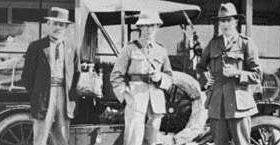
They faced challenges like crossing rivers without bridges. Fysh kept a diary with maps and photos to record their trip. They reached Katherine on October 8, 1919. From there, they took a train to Darwin. In total, they drove 2,180 kilometers in 51 days.
They realized that the original planned route for the air race was not good enough for planes to land. Fysh and McGinness thought a different route through the Barkly Tableland would be better.
When they reached Darwin, McGinness and Gorham went back to build landing routes. Fysh stayed in Darwin to create landing strips there and at Katherine. He suggested a new landing strip near Fannie Bay, north of Darwin. This strip was finished just before the winning pilots, the Smith brothers, arrived.
On December 10, 1919, Ross and Keith Smith, the winners of the Great Air Race, landed in Darwin. Hudson Fysh greeted them as the official representative. In May 1920, Fysh decided to return to Longreach. On his way, he met Alexander Kennedy, who told him about McGinness's idea for an airline service.
Starting Qantas: A New Era of Flight
After meeting again, McGinness and Fysh began planning their airline. They believed that planes would be very important for transporting mail, people, and goods in the remote areas of Australia.
McGinness had previously met a farmer named Fergus McMaster. McGinness had helped McMaster fix his broken-down car, earning his respect. When Fysh and McGinness went to Brisbane to develop their airline plan, they coincidentally met McMaster there. They explained their idea to him.
Their first plans included offering joyrides, air taxi services, and charter flights. On June 20, 1920, in Brisbane, McGinness, Fysh, McMaster, and an adviser named Alan Campbell started the process to register their new airline. It took several months to find a name and enough money for the business.
Fysh showed his belief in the airline by investing his savings of £A500. McGinness invested £1000. Arthur Baird, their flight engineer from the war, also joined them. A main investor was Ainslie Templeton, a friend of McMaster. Fysh and McGinness traveled through towns, asking for investments. People responded positively, often seeing it as a way to support young soldiers returning from the war.
After trying many names, they chose "Queensland And Northern Territory Aerial Services Limited," or Qantas. McMaster later said the name was inspired by "Anzac," which refers to Australian and New Zealand soldiers. Qantas was officially formed on November 16, 1920. McMaster became the chairman, and Winton was chosen as the first head office.
The original plans for joyriding changed to focus on airmail services. This would connect remote towns between Darwin and Longreach. This would make it the longest direct air service in the world at that time. Another idea came from Dr. Frederick Archibald Michod, a doctor in Longreach. He suggested a "flying doctor" service, which later became a reality.
Qantas got its first hangar, a wool store, from A.J.B. McMaster, Fergus's brother. On February 7, 1921, the first Qantas board meeting was held in Winton. They quickly decided to move the headquarters to Longreach. This location was more central and offered easier access for passengers and spare parts.
Qantas' First Planes and Flights
In August 1920, Fysh and McGinness ordered their first planes for Qantas. They bought two Avro 504K aircraft. However, there was a delay in getting the engines, which caused financial worries. They then decided to order a third plane, an Avro 547 triplane, which could carry four passengers in an enclosed cabin. This plane was considered very advanced.
The Avro 504K was finally ready on January 25, 1921. McGinness flew it. Fysh, however, needed a plane to fly back to Longreach. Charles Knight, a local agent, asked Fysh to fly a RAF B.E.2e biplane for him. Even though Fysh had only practiced on this type of plane for 30 minutes, he agreed.
On January 31, 1921, Fysh, McGinness, and Baird took off from Mascot Aerodrome (now Sydney Airport). Fysh's BE2e plane began to spin due to strong winds. He landed safely near a miner's cottage.
They then flew north, stopping at several towns. In Barcaldine, McMaster joined them. He wanted their arrival in Longreach to be "impressive and historical." They reached Longreach on schedule, even beating the mail train. They then planned the final part of their journey to Winton.
On February 7, 1921, Fysh flew with Charles Knight to Winton. McGinness, McMaster, and Ainslie Templeton flew in the Avro. McGinness got lost, making their one-and-a-half-hour trip take three hours. They finally landed in Winton with only 15 minutes of fuel left. A crowd cheered their arrival.
The next day, the two planes flew back to Longreach. Fysh again got lost, missing Longreach by 20 miles. He found his way back by following the Thompson River. This difficult journey was too much for Charles Knight. He sold his BE2e plane to Qantas for £A450 and swore he would never fly again.
Growing Qantas: From Local to Global
In 1922, Qantas won a contract for Australia's second scheduled air route. This route was between Charleville and Cloncurry. Hudson Fysh continued to pilot planes regularly until 1930. He also studied business and management. In 1923, he became the managing director of Qantas.
When an airmail route to England was planned, Qantas successfully bid for it. Fysh was deeply involved in planning this route from 1931 to 1933. The final agreement meant Qantas would fly the mail to Singapore. From there, British Imperial Airways would take over.
In 1934, Qantas and Imperial Airways created a new company called Qantas Empire Airways. Both companies owned half of it. Fysh became the managing director of this new company as well. He also helped start Tasman Empire Airways Ltd in 1940, which later became Air New Zealand.
Second World War greatly affected Qantas. Japanese attacks in Singapore destroyed half of Qantas' planes. The airport in Darwin was also attacked. Fysh, who was still an officer in the RAAF, took charge of using Qantas planes for war efforts. This included flights for evacuations and supplies.
In 1946, the Australian government bought Qantas. Fysh was the only manager who supported this decision. After the deal was done, he became the chairman of the now government-owned Qantas. He retired as managing director in 1955. After some disagreements with the Qantas board, he finally retired as chairman in 1966.
Published Works
Hudson Fysh was also a writer of aviation history. He wrote many books during and after his career. One of his books, Taming the North, published in 1933, tells the story of Alexander Kennedy. Kennedy was the first paying passenger for Qantas and a well-known farmer.
His most famous works were a series of three autobiographical books. These books covered the history of Qantas and its role in World War II. The first book, Qantas Rising: The Autobiography of the Flying Fysh, tells his life story. It covers his time in World War I and the growth of Qantas. Critics praised this book as one of the few autobiographies by airline pioneers.
The second book, Qantas at War, describes how Qantas changed during the war. This book was even compared to Winston Churchill's famous history series, The Second World War. Historians have said that Fysh's memoirs are very valuable for understanding the airline's history.
The third book, Wings to the World, was published in 1970. It describes Qantas's expansion, including the introduction of new planes like the Super Constellations and the start of the jet age. Fysh also wrote a biography about Henry Reed and a book about trout fishing.
Honors and Legacy
Hudson Fysh received many honors for his important contributions to aviation.
- In 1953, he was knighted, becoming a Knight-Commander of the Order of the British Empire. This means he was given the title "Sir."
- In 1971, he received an honorary Engineering Doctorate degree.
- After his death in 1974, he was named one of the "100 most influential Australians of the century" by the Sydney Morning Herald.
- In 2002, Fysh was added to the Pacific Air Travel Association's Gallery of Legends. This honored his "personal excellence" and his lifelong work in travel and tourism.
- In late 2008, a large Airbus A380 plane was named after Hudson Fysh. This was to recognize his huge impact on the aviation industry and Qantas.
- There is a street named Hudson Fysh Avenue in Parap, Northern Territory, near the old Darwin Airport runway.
- If you look at a sample Qantas Frequent Flyer card, you might see "W H Fysh" as the placeholder name.
See also
Images for kids



